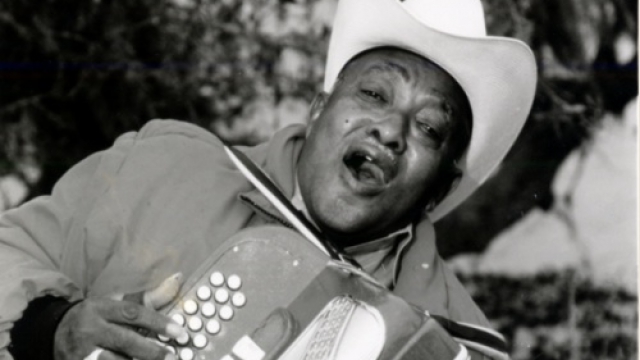
Wilson “Boozoo” Chavis
1930 – 2001

1930 – 2001
By Ben Sandmel
The popular zydeco accordionist Wilson “Boozoo” Chavis (pronounced CHAY-viss) had two career phases that were separated by a long hiatus. Born in 1928, Chavis was raised in the semi-rural section of Lake Charles, Louisiana, known as Dog Hill. He grew up listening to the Creole dance music known as “la-la,” a term used until “zydeco” succeeded it in common parlance in the 1950s. Chavis picked up music as a child by watching his father. “He played every weekend,” Chavis recalled in a 1987 interview. “I learned by watching him. I was nine years old. He’d work his fingers slow and tell me, “Do like this, do like that, push and pull.”
Chavis began playing zydeco dances in the late 1940s. His burgeoning reputation caught the attention of Eddie Shuler, owner of the Lake Charles-based Goldband and Folk Star record labels. In 1954 Chavis recorded “Paper in My Shoe” at Shuler’s studio. The song’s title referenced Chavis’ impoverished childhood: “We’d go to school and sometimes we didn’t have no socks. In the wintertime, we’d put paper in our shoes to warm our feet.” In 1955, Eddie Shuler licensed the record to the Los Angeles-based, nationally distributed Imperial label. With Imperial’s push, “Paper In My Shoe” became zydeco’s first hit single. According to Shuler it sold 130,000 copies. Whatever the actual sales figure may have been, Boozoo Chavis did not feel he received a fair share of the revenue. Years later he commented “If they came from Goldband today and asked me to make another record, I believe I’d have to shoot ’em.” Following a few more sessions for Goldband, Chavis quit the music business in disgust. For almost two decades he focused on training racehorses and raising his family.
In 1984 Chavis decided to give music a second try. He chose an opportune time. Zydeco and Cajun music were riding high on a wave of resurgent popularity. Chavis quickly re-established his following and emerged as one of the most popular artists on the zydeco dancehall circuit. He established a cottage industry of sorts by selling men’s briefs and women’s panties embossed with his name and the two-part instructions “Take ’em off! Throw ’em in the corner!”
Chavis also began recording again, this time with much better results. Despite its important status and commercial success, “Paper in My Shoe” had made a very poor representation of Chavis’ music. Chavis always played the accordion with an idiosyncratic sense of timing. When accompanied by musicians who knew his quirks, however, he could lock into a ferocious groove that kept dance-floors filled for hours. But the band that played on “Paper in My Shoe” couldn’t follow him. They were woefully out of tune, too – both with each other and with Chavis’s accordion. Adding insult to injury, Eddie Shuler loved to tell a tale alleging that Chavis got drunk during the session, fell off his chair, and finished recording “Paper In My Shoe” while lying flat on his back. Chavis’s disgust with this story was fueled in part by its condescension and implicit racial stereotyping. “Shit! How the hell you gonna keep playing like that?” he would ask with rhetorical rage. “They made that up.”
On his second time, around, though, Chavis’ sons formed the core of his band. They had no problem adapting to their father’s unorthodox sense of song structure. Chavis began recording again in 1986, making significantly better records, for a variety of labels, for the next 15 years.
Chavis did not match Clifton Chenier’s accordion prowess or versatile ability to “zydeco-ize” commercial R&B material. To the contrary, many of Chavis’ songs were simplistic one-chord vamps – played on a diatonic accordion – with no discernible melody, and minimalist lyrics. His 1986 hit, “Dog Hill,” for instance, consisted solely of the line “I’m going to Dog Hill, where the pretty women at!,” sung over and over. Chavis revitalized the rural zydeco scene with these catchy songs, inspiring a host of young admirers and imitators, and starting some entertaining trends. “Dog Hill” created a craze for zydeco songs with canine themes, complete with barking. Three years later, “Zydeco Hee Haw” spurred a similar fascination for songs about mules and singers who could imitate them. This aesthetic reflected the fact that many of Chavis’ fans lived a rural lifestyle as farmers and ranchers.
The latter profession explained Chavis’ penchant for performing in a cowboy hat and western wear. Many Creoles who came to dances dressed similarly. Chavis often performed at trail rides – elaborate celebrations where several dozen participants rode horses on a long route through the countryside, with stops at bars, dance halls, and farmhouses. As an avid equestrian, Chavis often trotted for hours before dismounting, strapping on his accordion, and playing a four-hour dance. And in the midst of the trail rides’ western trappings, a longstanding African-American folk tradition often emerged if Chavis could be coaxed into singing one of his X-rated hits. These songs combine rhyming couplets that boast of macho power and sexual prowess. African-American musicians and comedians have performed such material for many generations.
In 1991, Chavis recorded an album for the prestigious New York-based Nonesuch label, as part of its nine-volume American Explorer Series. This expanded Chavis’ circuit to performances around the U.S. and Canada, although – despite public demand – he could never be persuaded to fly overseas. He toured extensively for another decade, until falling ill on the road and passing away in Austin, Texas, in 2001. Boozoo Chavis left the world feeling quite secure about his importance in it. As he told the New York Times in 1992, “Sometimes I’m on stage looking at all those people dancing, and I feel sorry for them. I say to myself, ‘After you die, Boozoo, there ain’t gonna be no more like you.’ This is the best they’ve ever heard. I’m a genius, no doubt about it.”
———
Ben Sandmel is a New Orleans-based journalist, folklorist, drummer, and producer. Sandmel is the author of Ernie K-Doe: The R&B Emperor of New Orleans and Zydeco!, a collaborative book with photographer Rick Olivier. Sandmel has produced and played on albums including the Grammy-nominated “Deep Water” by the Cajun/country band The Hackberry Ramblers.
Suggested reading:
Olivier, Rick (photos) and Sandmel, Ben (text), Zydeco! Jackson, MS. University Press of Mississippi, 1999
Tisserand, Michael. The Kingdom of Zydeco. New York, Arcade Publishing. 1998

Accordions (from 19th century German Akkordion, from Akkord – “musical chord, concord of sounds”) are a family of box-shaped musical…